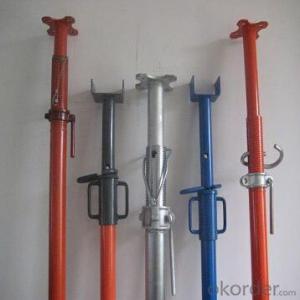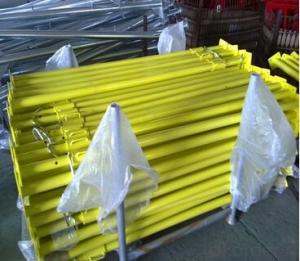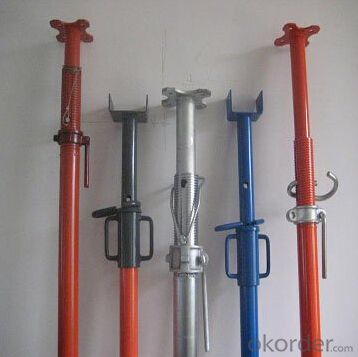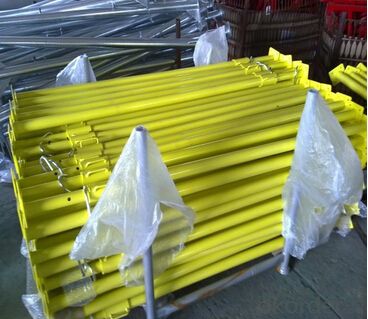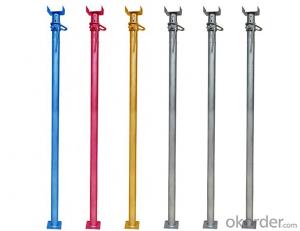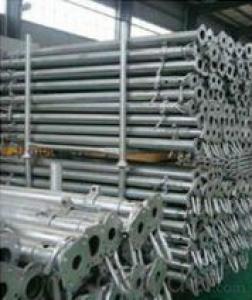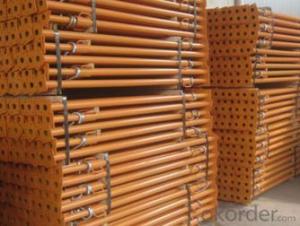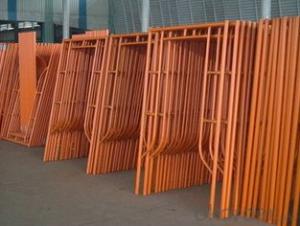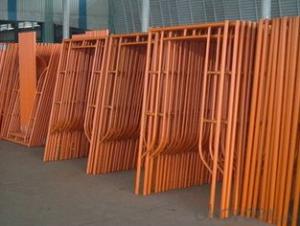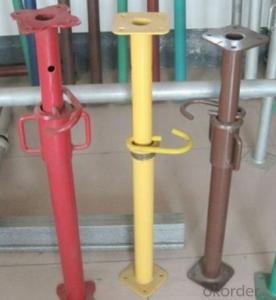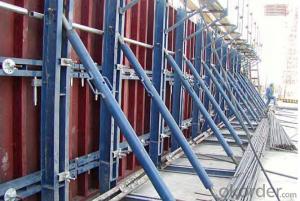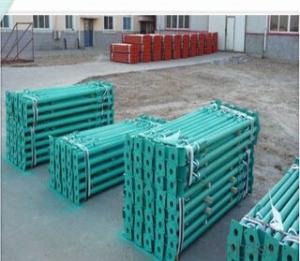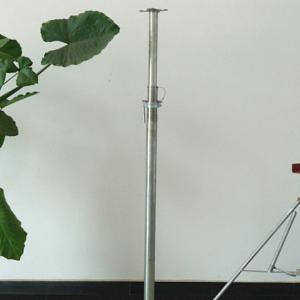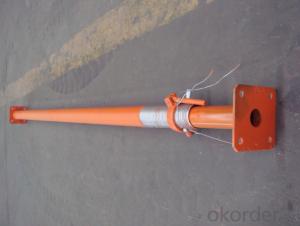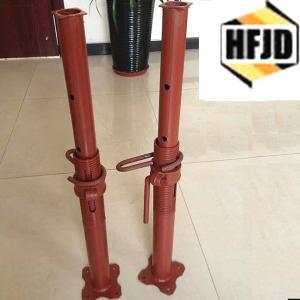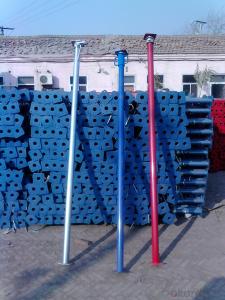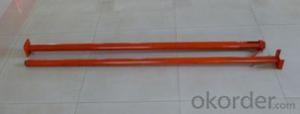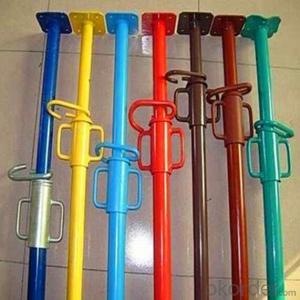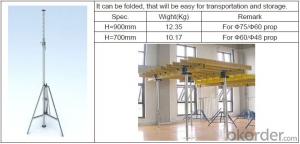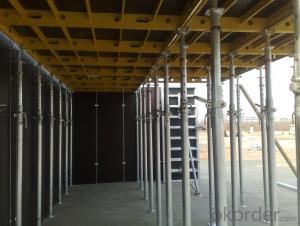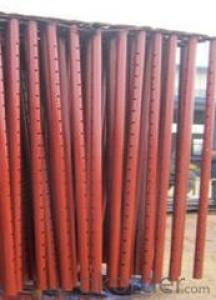adjustable scaffolding steel props/shoring props
- Loading Port:
- China Main Port
- Payment Terms:
- TT OR LC
- Min Order Qty:
- -
- Supply Capability:
- -
OKorder Service Pledge
OKorder Financial Service
You Might Also Like
Quick Details
| Type: | Scaffolding Part Type: | name: | |||
| surface: | diameter: | thickness: |
Packaging & Delivery
| Packaging Detail: | 1>bulk and loaded in container 2>bundled with steel strip 3>palletization 4>as to customes' need |
| Delivery Detail: | within 15 days after confirmed contract |
Specifications
1)Material:Q235
2)Weight :10-17.5kg
3)surface can be painted or galvanized
4)diameter:40mm;48mm;60mm
5)reasonable price
Scaffolding props;shoring prop;heavy duty steel props,
adjustable steel prop, steel props
| Item Code | Dimension | Inner Tube(mm) | Outer Tube(mm) | Material | Surface |
| ZSZ1630 | 1.6-3.0m | Φ48*3.0 | Φ60*3.0 | Q235 | Galvanized/Painted |
| ZSZ2035 | 2.0-3.5m | Φ48*3.0 | Φ60*3.0 | Q235 | Galvanized/Painted |
| ZSZ2240 | 2.2-4.0m | Φ48*3.0 | Φ60*3.0 | Q235 | Galvanized/Painted |
| ZSZ3048 | 3.0-4.8m | Φ48*3.0 | Φ60*3.0 | Q235 | Galvanized/Painted |
| ZSB1530 | 1.5-3.0m | Φ48*2.5 | Φ60*2.5 | Q235 | Galvanized/Painted |
| ZSB2035 | 2.0-3.5m | Φ48*2.5 | Φ60*2.5 | Q235 | Galvanized/Painted |
| ZSB2540 | 2.5-4.0m | Φ48*2.5 | Φ60*2.5 | Q235 | Galvanized/Painted |
| ZSQ1530 | 1.5-3.0m | Φ48*2 | Φ60*2 | Q235 | Galvanized/Painted |
| ZSQ2136 | 2.1-3.6m | Φ48*2 | Φ60*2 | Q235 | Galvanized/Painted |
| ZSQ2540 | 2.5-4.0m | Φ48*2 | Φ60*2 | Q235 | Galvanized/Painted |
We are manufacturer of various kinds of steel props . The product is in good quality with reasonable price , We can also manufatcure according to your demand and drawings ! Pls feel free to contact me if you are interested in our product!
Scaffolding prop
The steel prop with reasonable and highly capacity,At the construction site,it can
effectively reduce the amount of prop, so that the workers can have a big operating space and can handling the materials smoothly.
The speed of the set up is more 6 times than a traditional scaffolding and it can also save 70% artificial than the traditional
The steel prop without additional bracing and tripod-type were combined intoan
independent prop,stand-alone steel pillars form the basis of the whole structure
- Q: Can steel props be used for supporting temporary walkways or ramps?
- Yes, steel props can be used effectively for supporting temporary walkways or ramps. Steel props are strong and sturdy, making them suitable for providing structural support to ensure the safety and stability of temporary walkways or ramps.
- Q: Set up bearing platform, 9 meters long, width of 4 meters, height of 8.5 meters, the support of the corner of the 4, the length of the direction of the middle of the 4.5 meters (middle), bearing capacity of 150 tons, supporting columns need to choose how much H steel, beams need to choose how much of the H steel, how to calculate?
- Through the comparison of the structure scheme and the detailed structural calculation, the designer can finally determine and select the appropriate column, beam, tie rod, platform steel plate and other steel models
- Q: Can steel props be used for temporary support in telecommunications tower construction?
- Yes, steel props can be used for temporary support in telecommunications tower construction. Steel props are often used in construction projects to provide temporary support to structures or components during various stages of the construction process. In the case of telecommunications tower construction, steel props can be used to provide additional stability and support to the tower during the initial construction phase. These props can be adjusted and positioned as needed to ensure that the tower remains stable and secure during the construction process. Once the tower construction is complete and it is able to stand on its own, the steel props can be removed. Overall, steel props can be a reliable and effective solution for providing temporary support in telecommunications tower construction.
- Q: Do steel props require any special certifications or inspections?
- Yes, steel props typically require special certifications and inspections in order to ensure their safety and compliance with industry standards. These certifications and inspections are necessary because steel props are commonly used in construction projects to provide temporary support to structures during construction or renovation. The specific certification requirements may vary depending on the country or region, but in general, steel props are required to meet certain standards such as ISO 9001 (quality management), ISO 3834 (welding quality requirements), and EN 12811-1 (temporary works equipment). Certifications for steel props are typically obtained from accredited certification bodies that specialize in assessing the compliance of construction equipment with relevant standards. These bodies conduct thorough inspections and tests to ensure that the props are structurally sound, have proper load-bearing capacities, and are built to withstand the anticipated working conditions. Inspections of steel props are important to verify their condition and ensure that they are being used correctly and safely on construction sites. Regular inspections help identify any potential defects or signs of wear and tear that could compromise the props' integrity and safety. Inspections are usually carried out by qualified personnel, such as structural engineers or certified inspectors, who are trained to identify any issues and recommend necessary actions, such as repairs or replacements. In summary, steel props typically require special certifications and inspections to ensure their compliance with industry standards and guarantee their safety on construction sites. These measures are in place to protect workers and ensure the stability of structures during construction or renovation projects.
- Q: Which kind of steel is strong
- Look at what you do, if it is to build a house, then the preferred H steel
- Q: Can steel props be used in the construction of underground parking garages?
- Yes, steel props can be used in the construction of underground parking garages. Steel props provide structural support during construction and are commonly used to reinforce the walls and ceilings of underground structures. Their strength and durability make them suitable for the demanding conditions of underground parking garages.
- Q: 7.5 square meters of toughened glass floor C steel support costs about how much
- Do not want to talk about the width of the beam, how to calculate the beam width of the cross section of the vertical spacing required?
- Q: How much space should be filled in the steel pipe support of 70cm thick ground floor?
- It is important to note that the length of the front beam is usually 1.1 m -1.3 M. The maximum extension shall not exceed 1.7 meters, if the construction needs, the front beamLength of more than 1.3 meters, must take corresponding safety measures, accordingly reduce work load or increase the weight, guarantee of safety against overturning coefficientIn 2(5) the steel wire rope is fixed at one end of the reinforcing steel wire rope and the rolling wheel which is connected with the front beam, and the steel wire rope clamp is tightly screwedThe utility model is characterized in that: the utility model is characterized in that: the utility model is characterized in that: a pin shaft of the small connecting sleeve is arranged on the other end of the steel wire rope, and the closed end of the rope passing through the rigging spiral buckle is fixed with a steel wire rope clamp to adjust the screw of the screw buckle.(6) the working steel wire rope and the safety rope are respectively fixed on the front beam steel wire rope hanging plate according to the above method, and an upper limit block is arranged at the proper place of the safety wire.
- Q: How do you determine the required number of steel props for a project?
- In order to calculate the necessary quantity of steel props for a project, there are several factors that need to be taken into consideration. First and foremost, it is crucial to evaluate the load that the props will be supporting. This involves assessing the weight of the structure or formwork that the props will be utilized to support. The total weight that each prop will bear must be calculated to ensure they have sufficient capacity to safely handle the load. Subsequently, the spacing between the props should be considered. The distance between the props depends on the size and weight of the structure or formwork, as well as the type of props being employed. Generally, for heavier loads or larger structures, the spacing between props should be smaller. The height of the structure or formwork is another essential factor to take into account. The taller the structure, the greater the number of props required to ensure stability and prevent any sagging or deflection. The height-to-base ratio is often used as a means of determining the number of props needed, with higher ratios necessitating more props. Moreover, the type and quality of the props should be factored in. Different props possess varying load capacities, therefore it is vital to review the manufacturer's specifications to ensure that props capable of safely supporting the expected load are being utilized. Finally, it is important to consult any applicable codes or regulations governing the use of props in your region. These regulations may provide specific guidelines or requirements for determining the number of props needed for a particular project. By carefully considering the load, spacing, height, prop type, and relevant regulations, the required number of steel props for a project can be accurately determined. It is always advisable to seek the guidance of a structural engineer or a professional experienced in formwork and scaffolding to guarantee the safety and efficiency of the prop installation.
- Q: How do steel props withstand lateral forces?
- Steel props, also known as steel shoring or steel shores, are structural supports used in construction to temporarily hold or brace a structure. They are designed to withstand various forces, including lateral forces. Steel props are typically made of high-strength steel, which provides them with the necessary rigidity and strength to withstand lateral forces. The props are designed with a tubular shape, which helps distribute the forces evenly along their length. To enhance their resistance to lateral forces, steel props are often equipped with adjustable features. These features allow the props to be securely tightened against a structure, providing additional stability and preventing movement caused by lateral forces. Furthermore, steel props can be interconnected and braced together, creating a system that enhances their overall resistance to lateral forces. This system of interconnected props forms a stable framework that can distribute and resist lateral forces more effectively. In addition to their structural design, steel props can also be reinforced with additional bracing elements, such as diagonal struts or cross braces. These elements further enhance the props' ability to withstand lateral forces by adding extra support and stability to the structure. Overall, steel props are specifically engineered to withstand lateral forces by combining high-strength steel construction, adjustable features, interconnection, and additional bracing elements. This ensures that they provide the necessary support and stability to safely withstand the lateral forces encountered during construction or temporary shoring applications.
Send your message to us
adjustable scaffolding steel props/shoring props
- Loading Port:
- China Main Port
- Payment Terms:
- TT OR LC
- Min Order Qty:
- -
- Supply Capability:
- -
OKorder Service Pledge
OKorder Financial Service
Similar products
Hot products
Hot Searches
Related keywords
